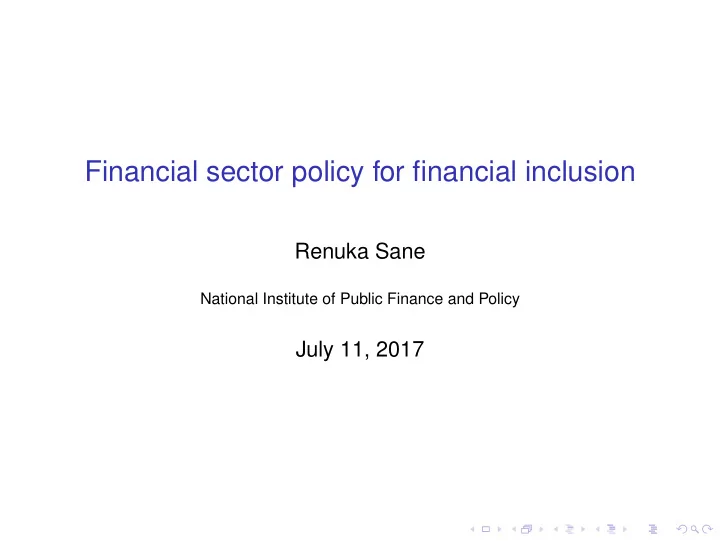

Financial sector policy for financial inclusion Renuka Sane National Institute of Public Finance and Policy July 11, 2017
Telecommunications in India Stage 1: Setting an objective National Telecom Policy 1994 envisioned universal access and availability. Stage 2: State-driven supply BSNL and MTNL were mandated to achieve at least one payphone per village. Result: Failure. Stage 3: Recognising the need for a market In 1997: Over 2K billion rupees was needed for universal telecommunications access. Stage 4: Market-driven approach Private participation, fair licensing, level playing field, setting up a well-designed regulator etc.
Telecommunications in India Result 100.00 Cellular density per 100 (Logarithmic Scale) 10.00 1.00 0.10 0.01 High Income countries India Source: World Development Indicators 1995 2000 2005 2010 2015
The curious case of finance Stage 1: Setting an objective Universal financial inclusion (bank account, basic insurance and some pension). Stage 2: State-driven supply Regulators and policymakers come up with a new product idea, make state-run firms supply it regardless of its viability. Stage 3: Recognising the need for a market There has been little or no effort to focus on the foundations required for a market-based approach. Stage 4: Market-driven approach Policy goal was always to use state-run firms to take finance through the last mile.
What ails viability in finance? Some thoughts ◮ Licensing requirements : The state actively prefers less competition in financial service providers.
What ails viability in finance? Some thoughts ◮ Licensing requirements : The state actively prefers less competition in financial service providers. ◮ Financial repression : The state actively gathers a large share of resources, leading to shortage of capital
What ails viability in finance? Some thoughts ◮ Licensing requirements : The state actively prefers less competition in financial service providers. ◮ Financial repression : The state actively gathers a large share of resources, leading to shortage of capital ◮ Failures on consumer protection : The problems of consumer protection remain unresolved.
What ails viability in finance? Some thoughts ◮ Licensing requirements : The state actively prefers less competition in financial service providers. ◮ Financial repression : The state actively gathers a large share of resources, leading to shortage of capital ◮ Failures on consumer protection : The problems of consumer protection remain unresolved. ◮ Regulatory uncertainty : The state is not consistent about policy.
What ails viability in finance? Some thoughts ◮ Licensing requirements : The state actively prefers less competition in financial service providers. ◮ Financial repression : The state actively gathers a large share of resources, leading to shortage of capital ◮ Failures on consumer protection : The problems of consumer protection remain unresolved. ◮ Regulatory uncertainty : The state is not consistent about policy. There is little desire to innovate and find solutions to achieve universal financial inclusion.
Licensing requirements ◮ Limited entry ◮ Since 1991, only 14 universal banks have been licensed. ◮ Strict restrictions on the “form” of the financial institution. ◮ Licenses have been granted for 10 small finance banks and 11 payment banks. ◮ Still not sure about how to think about P2P lending. Affects fund-raising and expansion plans (ET, May 2017) ◮ High capital requirements ◮ NBFC regulations on liquid funds in G-secs, and capital against poor loans (Roy, 2015). ◮ High proposed minimum paid up capital and net worth requirements for pre-paid payment instruments (PPIs), which seems disproportionate to the risk (Batra, Shaikh and Zaveri, 2017). ◮ Where is the competition going to come from?
Financial repression ◮ No liquid bond market. Over reliance on banks for capital. ◮ Within banks, high SLR requirements. ◮ Very limited investments by pension funds/insurance funds into non government securities (Halan, 2014) ◮ Limits on foreign investors (Zaveri and Pandey, 2016) ◮ Example: if MFIs cannot borrow at low cost, they will not lend further at low cost. ◮ Where is the capital going to come from?
Failures on consumer protection ◮ Numerous examples of mis-selling in Indian retail markets (Halan, Sane, Thomas, 2014; Halan and Sane, 2017). ◮ Difficult for low cost clean products to compete with high cost opaque products when customers are not discerning. ◮ Example: The National Pension System. Low cost, transparent pension product. Has found it difficult to compete.
Regulatory uncertainty ◮ Sudden policy changes that make scale difficult. ◮ Example: Atal Pension Yojana replaced the NPS-Swavalamban scheme in 2014. ◮ How do you invest in distributing a long term pension product if policy changes every few years? ◮ Lack of reasoned orders: Orders must state why the state is taking a particular action. ◮ Example: RBI order refuses Issue of Authorisation to Zoha Inc, USA to Operate Cross Border Money Transfer Service in India. No reason given for why the company was banned. No details on what procedure was followed for this order (Roy, 2011). ◮ Example: Analysis of IRDAI orders shows that reasons for imposing different penalties for similar offences are not clearly established in the orders (Aggarwal and Behl, 2016)
Way forward ◮ Forcing financial institutions, mostly banks, to do financial inclusion has meant that banks see inclusion as an obligation not an opportunity. ◮ Commercial viability is important. ◮ Think about features of the policy landscape that inhibit viability ◮ Balance with the need for consumer protection ◮ Build an ecosystem where a thousand flowers bloom .
Thank you.
Recommend
More recommend